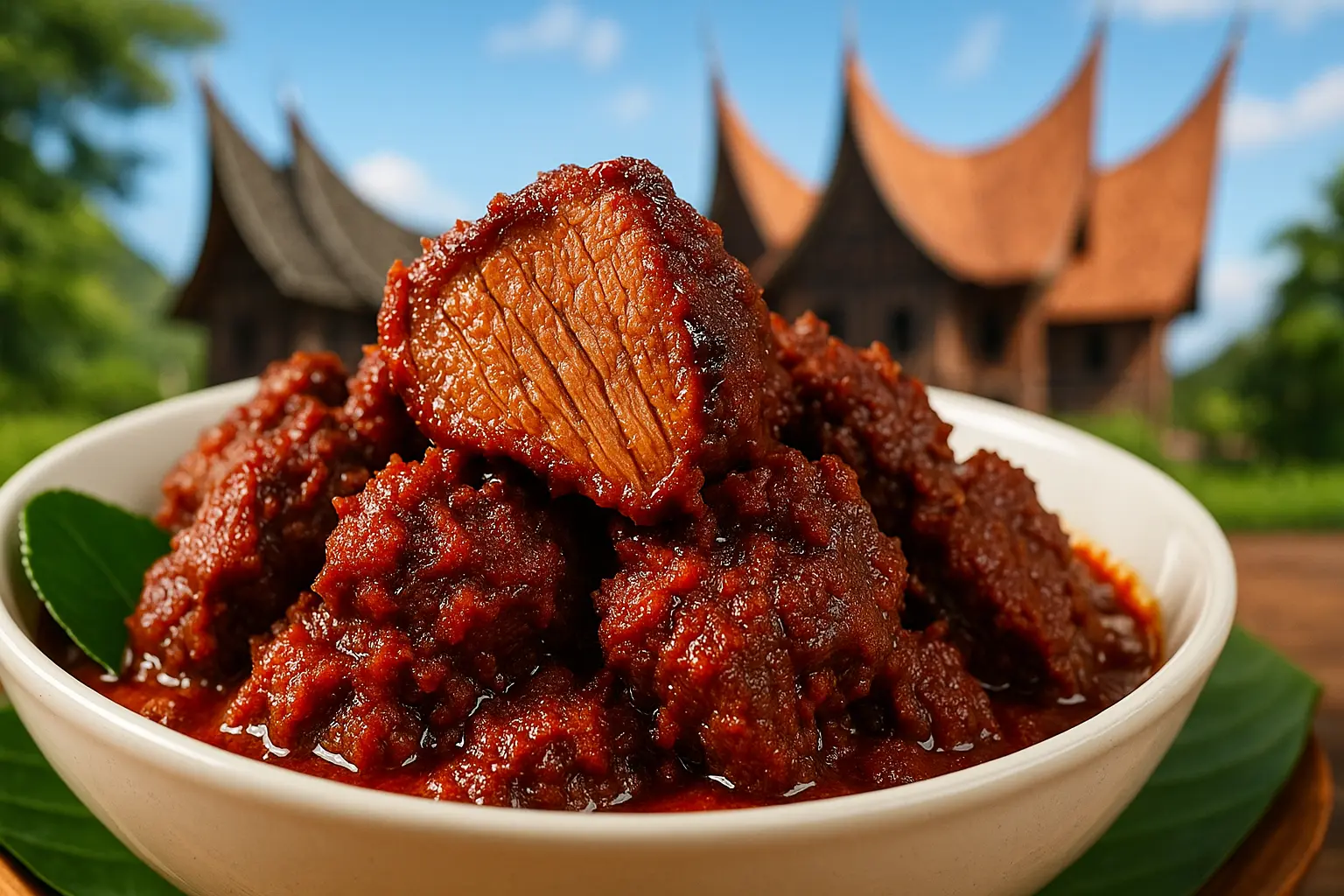Rendang, the richly spiced meat dish from Minangkabau, Indonesia, has gained global fame, consistently recognized as one of the world’s most delicious foods. As a cornerstone of Traditional Indonesian Food, Rendang’s appeal lies not only in its complex flavors but also in the unique preparation methods that vary across regions.

But did you know that the cooking technique can significantly impact the final taste and quality of your Rendang? Let’s dive into the differences between stir-frying and stewing methods for achieving the perfect Rendang!
See Table of Contents
Understanding the Two Key Rendang Cooking Methods
When it comes to preparing Rendang, two primary methods are commonly employed:
- Stewing (Gulai Method): This traditional method involves cooking solid ingredients in a liquid, such as coconut milk or broth, for an extended period. Stewing ensures the ingredients are thoroughly cooked and allows the liquid to slowly reduce, making it a common approach for Rendang. In this method, spices can be directly added to the coconut milk solution.
- Stir-Frying (Tumis Method): In contrast to stewing, stir-frying is a quick cooking technique using a small amount of fat at high temperatures. Its purpose is to extract and enhance the flavors from ingredients and spices while retaining their integrity. When stir-frying the spices for Rendang, it’s crucial to use medium heat to prevent burning and ensure the spices are perfectly cooked.
The Quality Showdown: Which Method Comes Out on Top?
This blog post is based on a scientific experimental study published in the Jurnal Pendidikan Tata Boga dan Teknologi (Journal of Culinary Arts Education and Technology). The research involved three repetitions, with data collected from 5 limited panelists who completed an organoleptic questionnaire. The findings were analyzed using a statistical T-test, evaluating Rendang’s quality based on its shape, color, aroma, texture, and taste.
Here are the intriguing findings:
Appetizing Rendang Color:
- Dedak (Spice Paste/Residue) Color: Rendang prepared using the stir-frying method achieved the best brownish-black “dedak” color, with an average score of 3.87. This is likely due to the stir-frying process introducing additional oil (beyond the natural coconut fat), which evenly fries the “dedak” and meat at a consistent high temperature.
- Meat Color: The meat in stir-fried Rendang also showed the best reddish-brown color (average score 3.67). This happens because stir-frying the spices and meat allows the meat’s natural juices to be released and replaced by the oil infused with spices, ensuring even cooking.
Signature Fragrance of Rendang:
- The stir-frying method consistently excelled in producing the most aromatic Rendang (average score 3.73). Stir-frying spices is highly effective in releasing and enhancing their inherent flavors.
Perfect Texture:
- Meat Texture: Stir-fried Rendang yielded the tenderest meat texture (average score 3.80). This suggests that the stir-frying process of both spices and meat positively influences the meat’s tenderness.
- Dedak Texture: Interestingly, for the texture of the dry “dedak,” the stewing method performed best (average score 3.80). This could be because stewed Rendang primarily relies on natural oils from the cooked coconut milk, without additional oil, resulting in a drier “dedak” texture.
Rich and Absorbed Flavor:
- Savory Dedak Flavor: Rendang prepared with the stewing method achieved the best savory “dedak” flavor (average score 3.87).
- Well-Absorbed Spices: However, the best-absorbed spice flavor in the meat was found in Rendang made with the stir-frying method (average score 3.73). This is evident because during stir-frying, meat juices are released and replaced by the stir-fried oil infused with spices, allowing them to penetrate deeply into the meat.
Conclusion: Is Stir-Frying the Key to Superior Rendang Quality?
The research indicates that different processing methods significantly impact the color quality of Rendang’s “dedak.” This was confirmed by the T-test, where the calculated t-value was greater than the t-table value, signifying a significant influence on this specific quality aspect. For other quality attributes (meat color, aroma, texture, and taste), the t-value was less than the t-table value, indicating no significant difference. Overall, the highest quality score for Rendang meat in this study was achieved using the stir-frying (X2) method.
Tips for Making Delicious Rendang at Home
Based on this research, here are some practical tips you can apply when preparing Rendang at home:
- When stir-frying your spices, use medium heat to prevent burning and ensure maximum flavor release.
- For the best Rendang, opt for tender cuts of beef such as beef tenderloin or sirloin.
- Cut the meat into uniform cubes using a sharp knife to ensure even cooking and better texture.
So, are you curious to try making Rendang with the stir-frying method for optimal color and aroma? Give it a try and may your Rendang be the most delicious ever!
Authored by:
This article is a summary of scientific research conducted by Afdal Akbar and Wiwik Gusnita, published in the Jurnal Pendidikan Tata Boga dan Teknologi, Universitas Negeri Padang.
Original Scientific Article Source:
Jurnal Pendidikan Tata Boga dan Teknologi
Volume 1 Number 2, Pages 111-117 (2020)
DOI: 10.2403/80sr.37.00
Readers can access the full scientific article directly here:
http://boga.ppj.unp.ac.id/index.php/jptb/article/view/37
